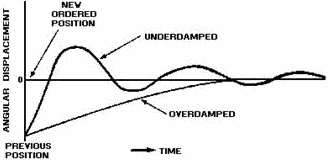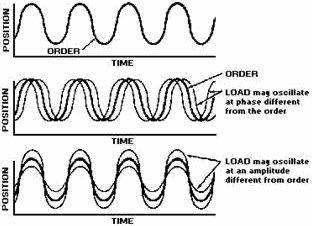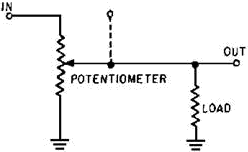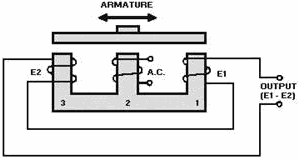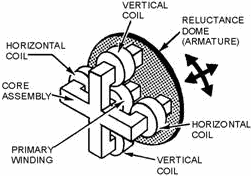Introduction to Test Equipment |
||||||||||||||||||||||||||||||||||||||||||||||||||
|
NEETS Module 15 − Principles of Synchros, Servos, and Gyros Pages i, 1−1, 1−11, 1−21, 1−31, 1−41, 1−51, 1−61, 1−71, 2−1, 2−11, 2−21, 2−31, 3−1, 3−11, 3−21, 4−1, Index
decreased, the error signal would increase in amplitude and cause the motor to speed up. In the same way, if the antenna were to speed up, the tach output would increase, decreasing the error signal and the motor would slow down. Without the velocity loop to compensate for changing conditions, the load could not respond in the desired manner.
The system shown in figure 2-7 is a simplified version of a velocity loop. In practice, the reaction of the motor to error voltage and the output of the tach would not be equal (10 rpm per volt and 1 volt per 10 rpm). This would be compensated for by gearing between the motor and load and between the load and tach, or by using a summation network in which the resistors (R2 and R3) are riot equal. This use of unequal resistors is called a SCALING FACTOR and compensates for tach outputs and required motor inputs. This is just another way of saying that the individual components of the velocity loop must be made to work together so that each can respond in a manner that produces the desired system result.
Q-9. What are two major differences between velocity servos and position servos?
Q-10. In a typical velocity servo block diagram what device is placed in the feedback loop that is not present in the position servo?
Q-11. What is the advantage of using a closed-servo loop to control load velocity?
The Acceleration Servo
The acceleration servo is similar to the two loops we just discussed except that the acceleration of the load is sensed, rather than the position or velocity. In this loop, the tachometer of the velocity loop is replaced by an accelerometer (a device that generates a signal in response to an acceleration) as the feedback device.
We have not provided an illustration of the acceleration servo because of the complexity of its applications as well as its components. This type of servo is widely used in the rocket and missile fields, and is used whenever acceleration control is required.
SERVO Characteristics
Servo characteristics vary primarily with the job the servo is designed to do. There are almost as many types of servos as there are jobs for servos. All servos usually have the common purpose of controlling output in a way ordered by the input. Ideally, motion and output shaft position should duplicate the track of the input shaft. However, this ideal performance is never achieved. We will discuss the major reasons for this, and show some methods used in the attempt to approach the ideal.
Because a servo compares an input signal with a feedback response, there will always be a TIME LAG between the input signal and the actual movement of the load. Also, the weight of the load may introduce an additional time lag. The time lag of the servo can be decreased by increasing the gain of the servo amplifier. If the gain is set too high, however, the servo output will tend to oscillate and be unstable. From this you can see that the gain of a servo is limited by stability considerations. Servo sensitivity must be considered along with stability to reach a "happy medium."
TIME LAG
To reduce time lag, the gain of the servo amplifier could be increased. Increasing the gain of the servo amplifier will decrease the lag time and cause the load to move faster. However, there is a serious drawback because the load is moving faster, its inertia will likely cause it to go past the desired position
2-11 (overshoot). When the load attempts to drive back to the desired position, the high gain of the amplifier may cause it to overshoot in the opposite direction. Therefore, the system must be stabilized to minimize or eliminate the problem of overshoot. This is done through DAMPING. Damping can be done by either introducing a voltage in opposition to the signal voltage or placing a physical restraint on the servo output. The actual function of this anti-hunting is to reduce the amplitude and duration of the oscillations that may exist in the system. Every system has one or more natural oscillating frequencies that depend on the weight of the load, designed speed, and other characteristics.
The degree of damping is determined by the purpose and the use of the system. If the system is OVERDAMPED, it will not be bothered by oscillations. However, the large amount of restraint placed on the servo presents an additional problem. This is an excessive time requirement for the system to reach synchronization. Figure 2-8 is a graphic representation showing the time relationship with regard to degree of damping.
Figure 2-8. - Degree of damping.
An UNDERDAMPED servo system has other traits. The favorable one is its instantaneous response to an error signal. The unfavorable trait is an erratic operation around the point of synchronization because of the low amount of restraining force placed on the servo. Somewhere between overdamped and underdamped, there is a combination of desirable accuracy, smoothness, and moderately short synchronizing time.
The simplest form of damping is FRICTION damping. Friction damping is the application of friction to the output shaft or load that is proportional to the output velocity. The amount of friction applied to the system is critical, and will materially affect the results of the system. Friction absorbs power from the motor and converts that power to heat.
A pure friction damper would absorb an excessive amount of power from the system. However, two available systems have some of the characteristics of a friction damper, but with somewhat less power loss. These are the friction clutch and the magnetic clutch.
Q-12. If a position servo system tends to oscillate whenever a new position is selected, is the system overdamped or underdamped?
Q-13. If a position servo system does not respond to small changes of the input, is the system overdamped or underdamped?
2-12 Friction Clutch Damping
The friction clutch damper uses a friction clutch to couple a weighted flywheel to the output drive shaft of the servo motor. As the servo motor rotates, the clutch couples some of this motion to the flywheel. As the flywheel overcomes inertia and gains speed, it approaches the motor speed. The flywheel, in turning, absorbs energy (power) from the servo motor. The amount of energy stored in the flywheel is determined by its speed (velocity). Because of inertia, the flywheel resists any attempt to change its velocity.
As the correspondence point of the system is approached, the error signal is reduced and the motor begins to slow down. In an attempt to keep the output shaft turning at the same speed, the flywheel releases some of its energy into the shaft. This causes the first overshoot to be large. When the servo system drives past the point of correspondence, a new error signal is developed. The new error signal is of opposite polarity and causes the servo system motor to drive in the opposite direction. Once again the flywheel resists the motor movement and absorbs energy from the system. This causes a large reduction in the second overshoot and all subsequent overshoots of the system. The overall effect is to dampen the oscillations about the point of correspondence and reduce the synchronizing time.
The motor rotation is transmitted to the flywheel through the friction clutch. The inertia of the flywheel acts as an additional load on the motor. The friction clutch is designed to slip with a rapid change of direction or speed. This slipping effectively disconnects the flywheel instantaneously, and thus governs the amount of power the flywheel draws from the motor. Magnetic Clutch
Another type of damper is the Magnetic CLUTCH. This type is similar in function to the friction- clutch damper. The main difference between the two is the method used to couple the flywheel to the shaft of the servo motor. There are two distinct types of magnetic clutch dampers. The first uses a magnetic field to draw two friction clutch plates together to produce damping. The action is similar to the friction clutch we just described.
The second version of the magnetic clutch uses the action of a magnetic field generated by two sets of coils, or one set of coils and the induced eddy currents, which result from rotation of the single set of coils near a conducting surface (the flywheel).
Coupling in this type of clutch is made by the interaction of two magnetic fields without a physical contact between the two. The two-coil or eddy-current type of magnetic clutch offers smoother operation than a pure friction clutch and has no problem of wear because of friction.
In summary, a smooth, efficient operating servo system can only be achieved by a system of compromises. As you recall, earlier we increased the gain of the amplifier to reduce time lag. This had the drawback of increasing hunting or oscillations about the point of correspondence. We overcame this difficulty through friction damping. This solved the problem of hunting and smoothed out servo operation but acted as part of the servo load. It caused a large first overshoot and increased the time lag. Some form of damping that can be used with high amplification to obtain smooth servo operation and minimum time lag is needed. The answer lies with the use of ERROR-RATE damping.
Q-14. Why is damping needed in a practical servo system?
2-13 Error-Rate Damping
Error-rate damping is a method of damping that "anticipates" the amount of overshoot. This form of damping corrects the overshoot by introducing a voltage in the error detector that is proportional to the rate of change of the error signal.
This "correction" voltage is combined with the error signal in the proper ratio to obtain the desired servo operation with reduced overshooting and minimum time lag.
The advantages of error-rate damping are as follows:
1. Maximum damping occurs when a maximum rate of change of error signal is present. This normally would occur as the servo load reverses direction.
2. Since a CHANGE in the signal causes damping, there is a minimum amount of damping when no signal, or a signal of constant strength, is present.
Error-rate voltages are generated by either electromechanical devices or electrical networks in the equipment. One electromechanical device widely used to generate an error-rate voltage is the tachometer generator. As you learned previously, its output voltage is proportional to the output velocity of the servo. Hence, the output voltage of the tachometer can be used to anticipate sudden movement changes of the load.
The compensating electrical network used for error-rate damping consists of a combination of resistors and capacitors forming an RC, differentiating or integrating network. You should recall that a differentiating circuit produces an output voltage that is proportional to the rate of change of the input voltage and that an integrating circuit produces an output proportional to the integral of the input signal.
Figure 2-9 shows a basic RC INTEGRATOR. It can be recognized by the output voltage being taken across the capacitor. R 1 is added in this circuit to develop the transient error signal (small variation in the signal from the error detector). The RC integrator is sometimes referred to as an INTEGRAL CONTROL Circuit and will be used to explain electrical error-rate damping.
Figure 2-9. - Error rate stabilization network using an RC integrator.
The network consists of a capacitor and two resistors connected in series with the servo amplifier. The components of this circuit are designed to work with a constant or very slowly changing error signal.
Initially, all of the error voltage is divided between R 1 and R2. But the longer the error voltage is applied, the more C1 charges, and the greater the voltage at the input of the amplifier. Because of the RC time of the circuit, it takes time for the capacitor to charge to the value of the error input signal. Because of the long charge time of C1, the circuit can not respond instantaneously to a rapid change in error signal.
2-14 What this means is that all error signals will be integrated (or smoothed out). The load will not respond as quickly. The inertia of the load will be reduced, and the system will be damped.
The capacitor, by not responding instantaneously to the error signal, causes the damping action. This action is used to stabilize the servo system at the new velocity. By tailoring the stabilization network (through the proper selection of the RC components) to the system's performance requirements and the type of load to be driven, undesirable load or performance characteristics can be minimized.
The various compensating networks that you will encounter will depend on the design of the individual servo system and will be covered in the associated system's technical manual.
In summary, the key to understanding compensating networks is to realize that components are chosen so the capacitor does not have time to charge and discharge in response to large, rapid fluctuations.
Q-15. Error-rate damping is effective because the circuitry has the capability of .................. the amount of overshoot before it happens.
Frequency Response
The frequency response of a servo is the range of frequencies to which the system is able to respond in moving the load. It is a characteristic of the system, chosen by the designers so the system will be able to respond to whatever frequencies are expected to be present in the input signal for the particular application.
Oscillating Input Signal
At first, we considered the input order to a servo as being suddenly put at a fixed desired value. Later, we studied the case where the order slowly increased to the desired value. Actually, the input order to a servo in a given application may accelerate, start, stop, or oscillate about a fixed point. We will now consider the actions of a servo while the order oscillates. When the order is constant, oscillations of the load are undesirable. When the order oscillates, the load must oscillate in a similar manner.
Let's assume that an oscillating input signal (order) is applied to a servo. The load may behave in several ways. Ideally, it would respond in perfect sync with the order. Actually, the amplitude and phase of the load are different from those of the order, figure 2-10. As we noted above, the frequency response of the system is normally designed so the load is able to respond to the order.
2-15
Figure 2-10. - Frequency response.
A servo may follow the order in amplitude and differ in phase; it may follow the order in phase, and differ in amplitude; or it may differ in both phase and amplitude.
Bandpass Frequencies in a Servo system
Servos are plagued by noise signals that ride through the system on desired electrical signals. These noise signals cause roughness in the servo system and must be eliminated to obtain smooth servo operation.
By examining the different signals in a servo system, we can determine which frequencies are related to the movement of the load and which ones are from noise sources, such as static, motors, harmonics, and mechanical resonances.
Filters in the signal circuit can be used to shunt some of the unwanted frequencies away from the amplifier, and allow only those frequencies that represent load movement to enter the amplifier. This can also be accomplished by designing the Bandwidth of the servo amplifier to accept only the range of frequencies that represents valid servo signals and to reject all others. This smooths servo response, but has the drawback of reducing amplifier gain. Reduced amplifier bandwidth is another compromise in achieving optimum servo operation.
Q-16. In a properly designed servo system that has an oscillating input (order), what should be the response of the load?
Q-17. What is the advantage of designing a limited bandwidth into a servo amplifier?
2-16
SERVO COMPONENTS and Circuits
In this section we will discuss the circuits and components that make up a typical servo system. We cannot cover all possible servo applications here because of the vast number of servo system configurations. The circuits and components discussed in the following pages are the most commonly used and represent a broad view of the systems used in the Navy today. We have not attempted to put the units into any rigid classification system. We will mention some of the more common terms used by manufacturers and the Navy to classify the devices to familiarize you with the wide variety of nomenclatures.
We will be covering much of the electronic application without discussing the theory of the units. You may want to review some of the applicable NEETS modules or other sources before or during this discussion. You will find that much of the material necessary to understand these subjects is contained in the basic theory of electricity and electronics.
POSITION SENSORS
A position sensor is a device that changes a mechanical position into a voltage that represents that position. The output of a position sensor can be either ac or dc voltage. There are many different kinds of position sensors. In the last chapter you learned about the CX, a synchro device that represents the position of its rotor by a voltage on its stators. You saw a CX used as a position sensor in a servo system earlier in this chapter. Other devices can be used as position sensors. The potentiometer is one of these devices.
Potentiometers
Potentiometer position sensors are generally used only where the input and output of the servo mechanism have limited motion They are characterized by high accuracy and small size, and may have either a dc or an ac output voltage. Their disadvantages include limited motion and a life problem resulting from the wear of the brush on the potentiometer wire. Also the voltage output of the potentiometer changes in discrete steps as the brush moves from wire to wire. a further disadvantage of some potentiometers is the high drive torque required to rotate the wiper contact.
A potentiometer is one of the simplest means of converting mechanical positional information to a proportional voltage. a schematic representation of a potentiometer is shown in figure 2-11.
Figure 2-11. - a potentiometer.
2-17 A potentiometer is a variable voltage divider, with an output voltage that is a percentage of the input voltage. The amount of output voltage is proportional to the position of the wiper relative to the grounded end. For example, if the resistance from ground to the wiper is 50% of the total, the output voltage sensed by the load will be 50% of the total voltage across the potentiometer.
A basic, closed-loop servo system using a balanced potentiometer as a position sensor is shown in figure 2-12.
Figure 2-12. - Balanced potentiometer used In position sensing.
The command input shaft is mechanically linked to R1, and the load is mechanically linked to R2. a supply voltage is applied across both potentiometers.
The system is designed so that when the input and output shafts are in the same angular position, the voltages from the two potentiometers are equal and no error voltage is felt at the amplifier input. If the input shaft is rotated, moving the wiper contact of R1, an error voltage is applied to the servo amplifier. This error voltage is the difference between the voltages at the wiper contents of R1 and R2. The output of the amplifier causes the motor to rotate the load and the wiper contact of R2. This continues until both voltages are again equal. When the voltages are equal, the motor stops. In effect, the position of the output shaft has been sensed by the balanced potentiometer.
Q-18. When the input and output wipers of a balanced potentiometer are in the same angular position, what is the value of the error voltage?
ERROR DETECTORS
Electrical error detectors may be either ac or dc devices, depending upon the requirements of the servo system. An ac device used as an error detector must compare the two signals and produce an error signal in which the phase and amplitude will indicate the direction and amount of control, respectively, that are necessary for correspondence. a dc device differs in that the polarity of the output error signal determines the direction of the necessary correction. We will discuss in the following paragraphs various devices that are commonly used in servo systems.
2-18 Summing Networks
Summing networks, as we mentioned earlier, are used as error detectors in servo applications where the servo output must be proportional to the algebraic sum of two or more inputs. a typical circuit is shown in figure 2-13.
Figure 2-13. - Summing network as an error detector.
As in the case of potentiometers, the networks may use either ac or dc voltage, with the phase or polarity of the input voltage determining whether the signals are additive or subtractive. Refer to figure 2-13. If two input signals E1 and E2 are applied to the network, the network will provide an error voltage output that is proportional to the algebraic sum of the two signals. The servo motor drives the load and also a tachometer that supplies feedback voltage to resistor Rf. Resistor Rf nulls the error signal.
In some installations, the servo motor may position the wiper arm of a potentiometer instead of driving a tachometer to supply the feedback voltage.
E-Transformers
The E-transformer is a type of magnetic unit that is used as an error detector in systems in which the load is not required to move through large angles.
In the basic E-transformer shown in figure 2-14, an ac voltage is applied to the primary coil (2) located on the center leg of the laminated, E-shaped core. Two secondary coils (1 and 3) are wound series-opposing on the outer poles of the core. The magnetic coupling between the primary (coil 2) and the two secondaries varies with the position of the armature. The armature can be physically moved left or right in the magnetic circuit by mechanical linkage to the load. This changes the reluctance between either pole and the armature.
2-19
Figure 2-14. - Basic-E transformer.
When the armature is located in the center of the E-shaped core, as shown in the figure, equal and opposite voltages are induced in the secondary coils. The difference between them is zero. Thus, the voltage at the output terminals is also zero.
But, if the armature is moved, say to the tight, the voltage induced in coil 1 increases, while the voltage induced in coil 3 decreases. The two voltages are then unequal, so that the difference is no longer zero. a net voltage results at the output terminals. The amplitude of this voltage is directly proportional to the distance the armature has been moved from its center position. The phase of this output voltage, relative to the ac on the primary, controls the direction the load moves in correcting the error.
The basic E-transformer will detect movement of the armature in one axis only (either the horizontal or vertical depending upon the way the unit is mounted). To detect movement in both the horizontal and vertical axes, a CROSSED-E-Transformer is used.
If you place two E-transformers at right angles to each other and replace the bar armature with a dome-shaped one (fig. 2-15), you have the basic configuration of what is known as the crossed-E transformer, or pickoff. In most applications the dome-shaped armature is attached to a gyro, and the core assembly is fixed to a gimbal, which is the servo load.
Figure 2-15. - Crossed-E transformer.
2-20
|
||||||||||||||||||||||||||||||||||||||||||||||||||
